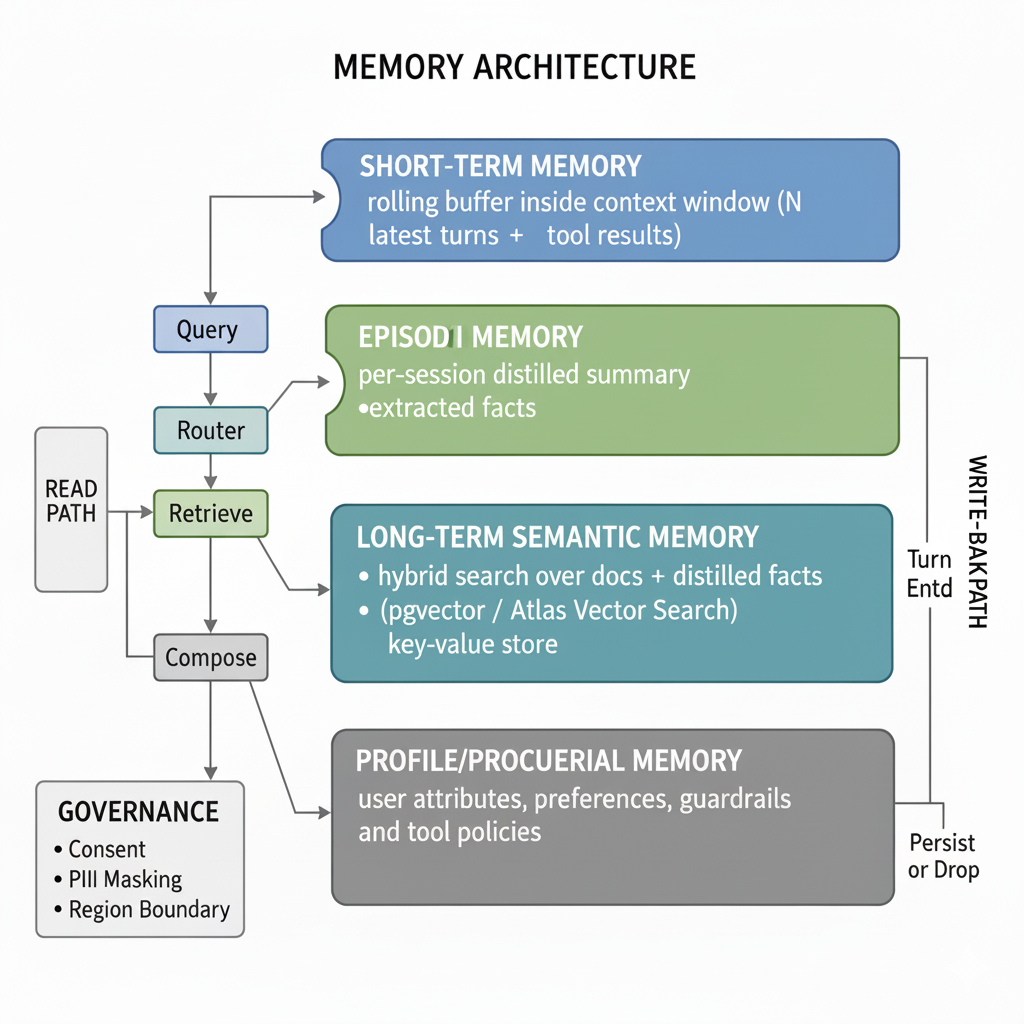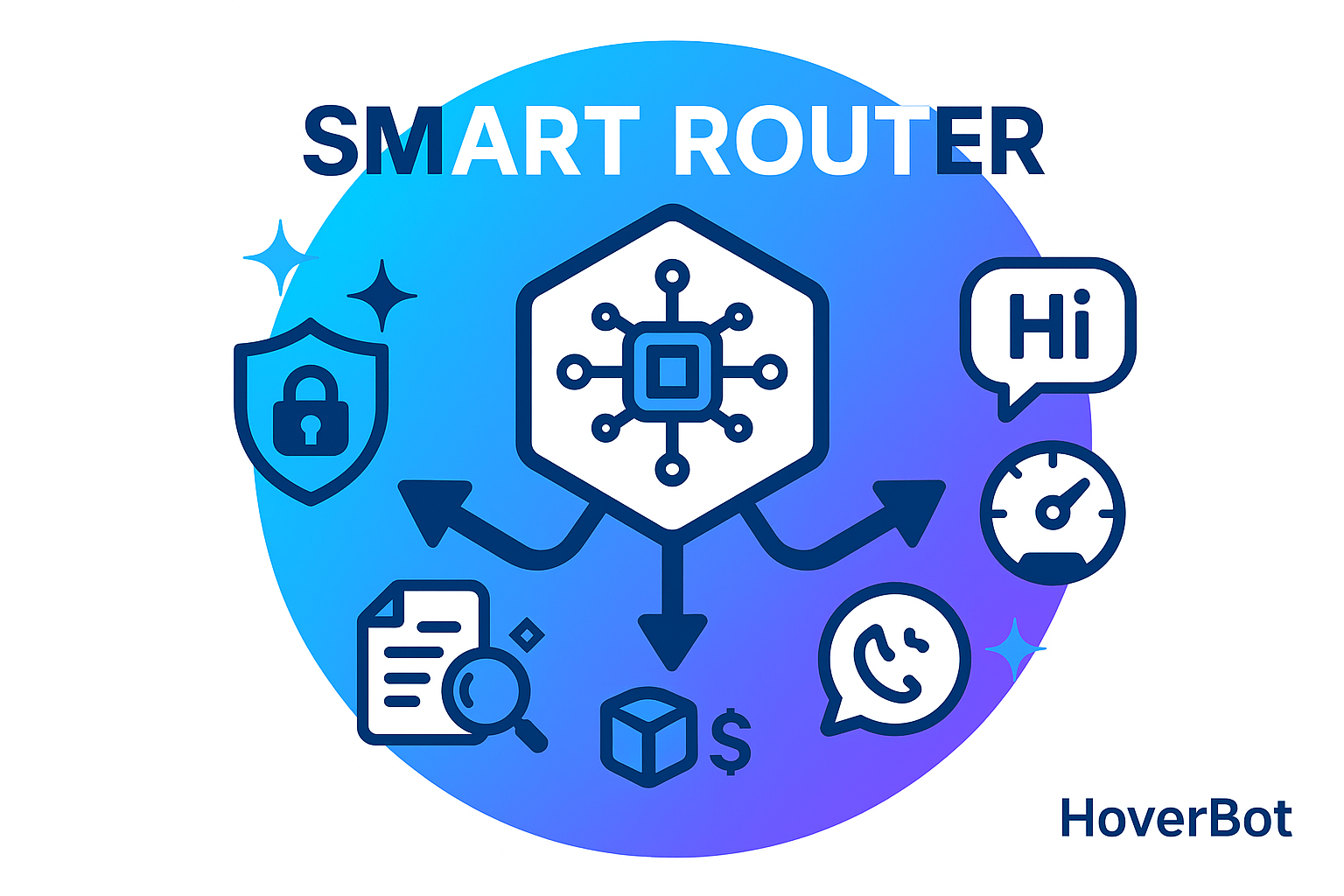How chatbots remember: short term, long term and everything in between

What memory is and is not
Chatbots do not retain everything by default. Models operate within a finite context window. Once that window fills, older turns drop out. Anything worth carrying forward must be deliberately persisted by the application. Teams decide what to save, how long to keep it, and when to reuse it.
The four layer model
In production, memory behaves like a stack of cooperating layers. Short term memory is the working context. It is a rolling set of recent turns that sustains coherence but fades fast. Episodic memory captures each conversation as a concise session note with goals, decisions and open items so future sessions start informed without replaying everything. Long term memory stores durable facts and preferences, retrieved with a mix of keyword and semantic search. It is powerful and therefore selective and consent driven. Procedural memory holds rules and guardrails. These are standing instructions a bot must always follow. They are kept versioned and auditable rather than transient.

Short term memory: the working context
Short term memory is the rolling conversation window. It maintains coherence within a single session by keeping recent turns in the model's context. When the window fills, older exchanges drop out on a first-in-first-out basis. This layer handles immediate follow-ups, pronoun resolution, and topic continuity.
Design for short term memory is about context management. Keep the window large enough for natural conversation flow but small enough to avoid diluting important information. Include system messages and guardrails that must always be present. Use compression techniques for longer conversations, such as summarizing older turns while preserving key facts.
Episodic memory: session summaries
Episodic memory captures the essence of each conversation session. When a conversation ends, the system generates a structured summary containing the user's goals, decisions made, actions taken, and open items. This summary enables future sessions to start with context without replaying the entire conversation history.
Effective episodic memory focuses on outcomes rather than transcripts. Instead of storing "user asked about pricing then said thanks," store "user interested in enterprise plan, needs custom quote, follow up scheduled." This approach reduces storage costs and improves retrieval relevance.
Long term memory: durable facts and preferences
Long term memory persists user preferences, account details, and behavioral patterns across many sessions. This layer enables personalization and builds user trust through consistency. Retrieval combines keyword matching for exact facts with semantic search for related concepts.
Long term memory requires careful curation. Not every user statement deserves permanent storage. Focus on explicit preferences, confirmed facts, and repeated behaviors. Implement consent mechanisms and expiration policies. Tag entries with confidence levels and sources for later validation.
Procedural memory: rules and guardrails
Procedural memory contains the rules, policies, and guardrails that govern bot behavior. Unlike other memory types, procedural memory is not learned from user interactions but is explicitly configured and versioned. This includes safety rules, business policies, escalation triggers, and compliance requirements.
Procedural memory must be reliable and auditable. Version all rule changes, test them in staging environments, and maintain clear rollback procedures. These rules should be loaded fresh for each conversation to ensure consistency and prevent drift.
Design guidelines for production
Collect less by default. Persist only what moves outcomes. Avoid full transcripts without a legal need. Focus on actionable insights, confirmed preferences, and resolved decisions. Every stored item should have a clear purpose and expected lifespan.
Gate write backs. Admit data only when relevant to likely future tasks, non sensitive, consented and tagged with a time to live. Implement validation rules that check for sensitivity, relevance, and user consent before persisting any information. Use confidence thresholds to filter unreliable data.
Give users control. Provide a memory center to view, delete or disable. Enforce tenant and regional boundaries. Users should be able to see what the system remembers about them, correct inaccuracies, and revoke consent for specific types of memory. Make these controls discoverable and easy to use.
Budget tokens and time. Prevent short term context from crowding out rules or citations. Track p50 and p95 latency. Memory retrieval adds overhead to every request. Implement caching, batch operations where possible, and set hard limits on memory retrieval time. Monitor the impact on response latency.
Log decisions. Record why an item was stored, which policy allowed it, and when it will expire or be revoked. Maintain audit trails for compliance and debugging. Include metadata about confidence levels, sources, and validation status.
How to know it is working
Evaluation should focus on whether the system recalls and applies saved facts correctly, whether sensitive information is filtered rather than retained, and whether support metrics improve once memory is enabled.
Scorecard to watch
- Recall accuracy on planted facts across sessions - Test whether the system correctly retrieves and applies previously stored information
- Harmful retention rate which should approach zero - Measure how often sensitive information is inappropriately stored
- Deflection and first contact resolution lift - Track improvements in support metrics after enabling memory
- Token and latency deltas at p50 and p95 after enabling memory - Monitor performance impact of memory operations
- User sentiment that it remembers me without feeling intrusive - Balance personalization with privacy concerns
Common failure modes
Teams run into trouble when they store too much by default, when session summaries introduce distortions that later masquerade as facts, or when preferences never expire and begin to mis personalize. Policy gaps around minors, regulated data or cross border transfers add avoidable risk. A single layer design that relies only on a vector store and calls it memory is another common source of drift.
Over-collection trap. Storing everything "just in case" creates noise that drowns out signal. It also increases privacy risk and storage costs. Focus on information that will likely be useful in future conversations.
Summary distortion. When session summaries contain inaccuracies or interpretations rather than facts, these errors compound over time. Validate summaries against original conversations and flag uncertain information.
Stale preferences. User preferences change over time. Implement expiration dates and refresh mechanisms for stored preferences. Allow users to update or delete outdated information.
Compliance gaps. Different user types and data types have different regulatory requirements. Implement age verification, data classification, and regional compliance rules from the start.
HoverBot approach
HoverBot separates memory into layers and treats persistence as a governed workflow. Short term context keeps conversations fluent. Episodic notes accelerate follow ups. Long term items enter only with consent and time limits. Procedural rules remain versioned and testable. Customers can choose industry specific profiles that tighten defaults for regulated settings and can review or revoke stored items at any time through an admin console.
Our memory architecture prioritizes transparency and control. Users can inspect what the system remembers, understand why information was stored, and make changes as needed. This approach builds trust while enabling the personalization that makes AI assistants truly useful.
Getting started
Start with short term memory to handle basic conversation flow. Add episodic summaries for multi-session continuity. Implement long term memory selectively for high-value use cases. Always begin with procedural memory to ensure safety and compliance.
Build user controls from day one. Memory without user agency creates liability and erodes trust. Design for transparency, consent, and correction from the beginning rather than retrofitting these capabilities later.
Share this article
Related Articles

Close the loop: analytics that teach your chatbot to fix itself
Many chatbots stall for the same reason. Unanswered questions build up and nothing changes. Learn how to capture every miss as a signal, turn real gaps into small updates, and run a weekly improvement loop that delivers results without bigger models.

Make a smart router the center of your chatbot
Strong chatbots rely on routing, not just bigger models. Learn how to build a three-lane routing system with safety gates, fast responses, and heavy processing that optimizes for quality, cost, and security.